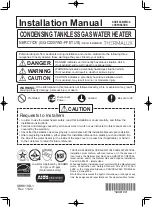
installed with good access to facilitate regular inspection and must be fitted with drainage
connections.
The vessel or vessels must be connected and equipped so as to prevent the formation of internal air
cushions or a vacuum. Unused connections must be professionally sealed.
The entire system must be thoroughly flushed before commissioning. It must be checked for leaks
under operating conditions and during maintenance.
The instructions provided with accessories apply separately.
Finally, affix the type plate on the insulation in a visible position.
4. Installing the insulation
Up to three people will be needed to install the insulation, depending on the size of the vessel. In the
case of variants intended for retrofitting (specially labelled), water-side installation can take place
before the insulation is installed.
1. The PUR soft-foam insulation should be raised to room temperature before use (
R
). The expansion
behaviour of the insulation surface changes in the event of low room and/or ambient
temperatures. For PVC surfaces: Installation can only take place when the insulation has reached
the recommended temperature of approx. 20 °C (
S
).
Installation is extremely difficult or even
impossible if this temperature is not reached
.
2. The perforated cut-outs must be cut-out as required with a suitable blade before applying the
insulation (
R
). The insulation can be used for different types of vessel. Please note which parts are
needed!
3. Place the insulation over the cut-outs and lay it evenly around the vessel (
S
). Starting at the centre
of the insulation, stroke and tap it with flat hands evenly in both directions to achieve a good fit
around the surface of the vessel, without air bubbles (
T
).
4. Close the zip-fastener or hook strips (1st or 2nd click position) slowly while pressing the foam
surfaces together (
W
).
5.
If necessary, re-adjust the insulation by tapping with flat hands and re-tightening the hook strips
(
T
).
6. Insert the round top section in line with the cut-outs and put on the deep-drawn cover (
Y
).
7. Glue or mount the escutcheons in place (
Y
).
8. Additional assembly of the vessel must be performed in accordance with the installation
instructions and applicable technical regulations (
Z
).
5. Inspection and maintenance
No liability shall be accepted for damage that is caused by failure to follow the installation and
operating instructions.
The vessel or vessels must be easy to access for maintenance, operation, any repairs or replacement.
The construction measures required for this are not the responsibility of the manufacturer or the
responsible distributor.
Constant topping up of the buffer vessel poses a risk of corrosion. The vessel must be included in the
potential equalisation.
Removal
Cool down and de-pressurize the system before removing the product from the system.
Local legislation must be adhered to when disposing of the various components.
ENG
3
Содержание PS 200
Страница 3: ...M M ...








































